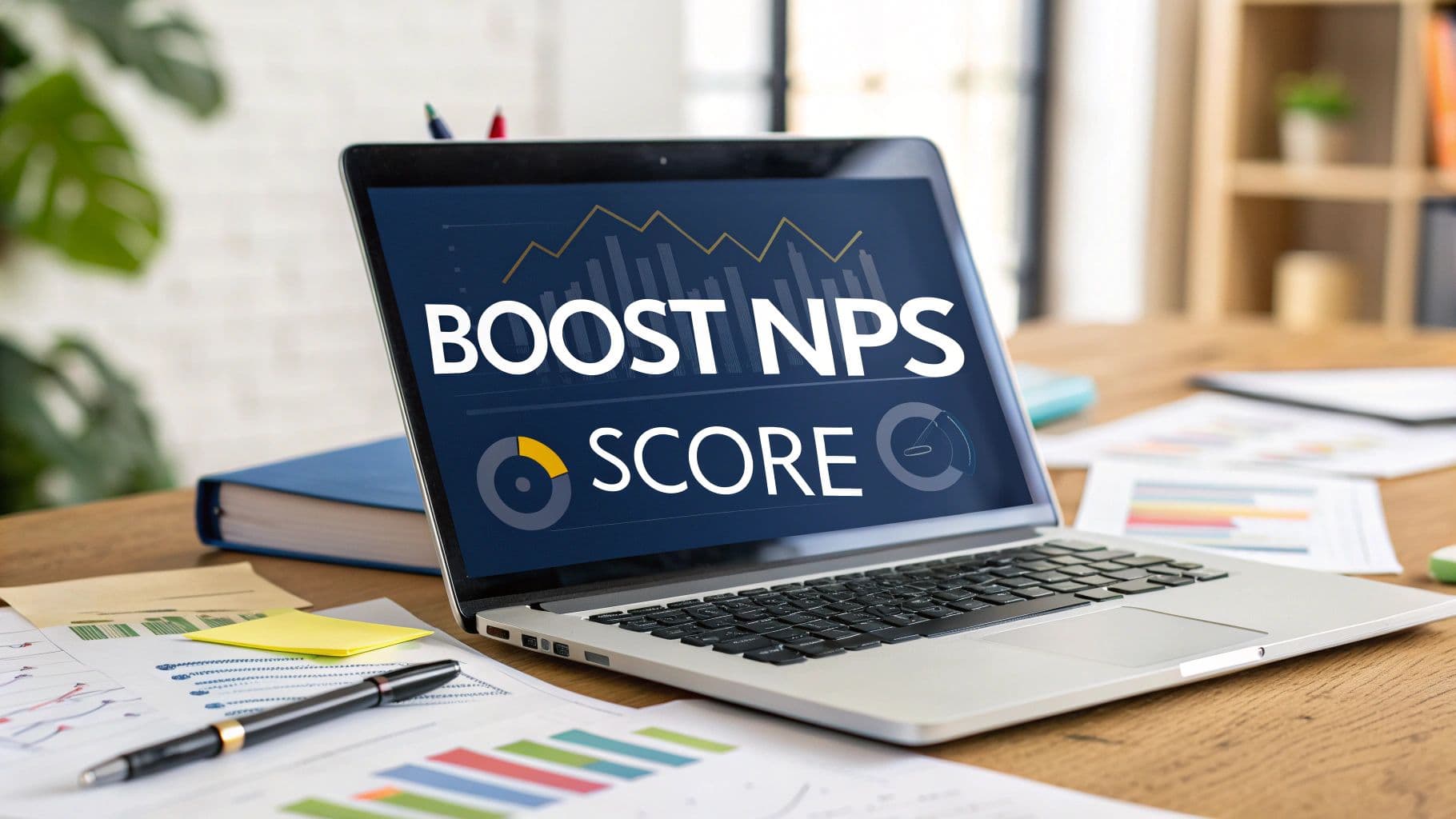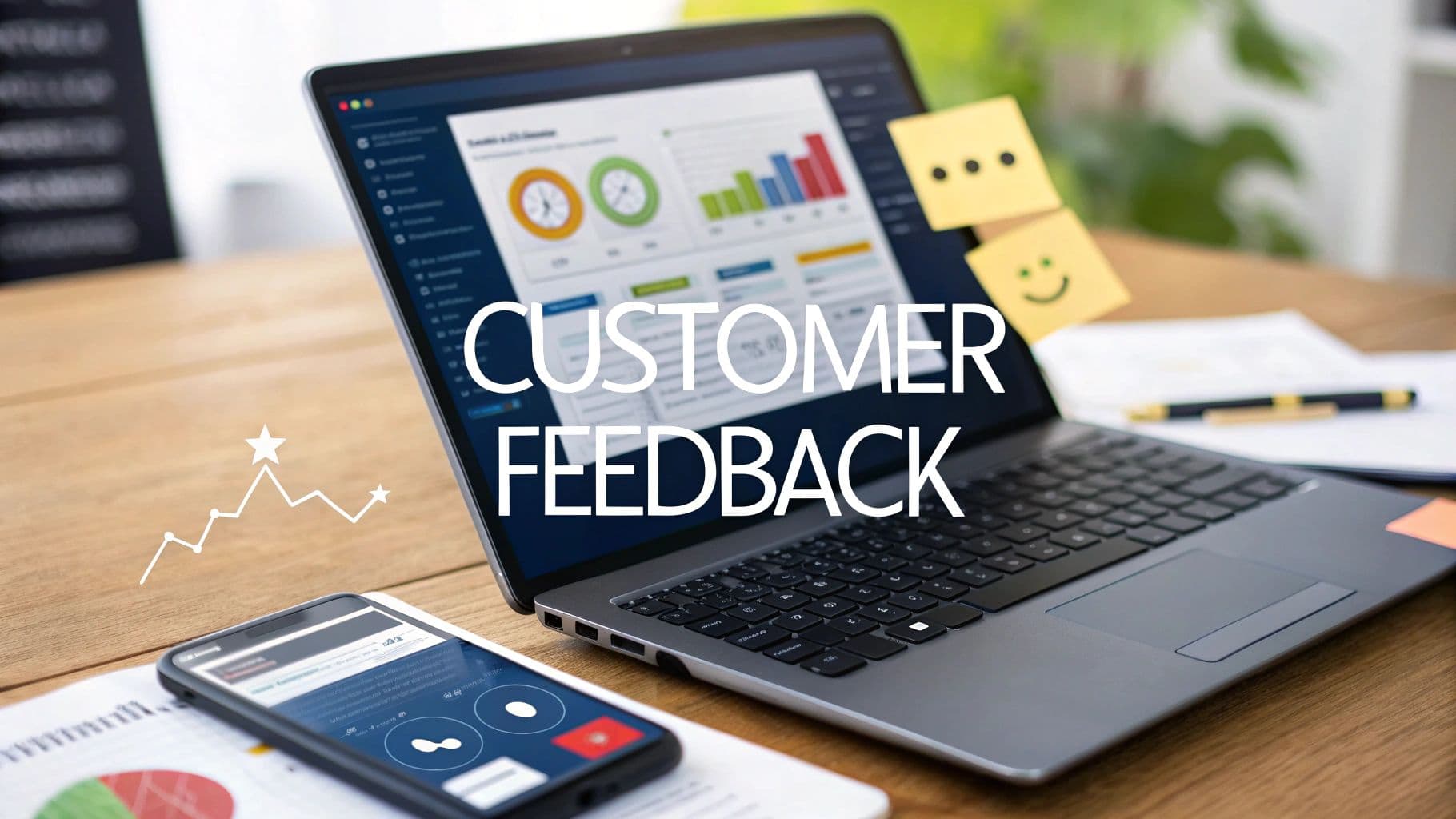How to Collect Feedback from Clients That Drives Growth
Learn how to collect feedback from clients with our practical guide. Discover proven methods, questions, and tools to unlock insights and improve your business.

Collecting client feedback isn't just about damage control; it's a powerful way to fuel your company's growth. When you strategically gather insights from your clients, you can boost client retention, kickstart real product innovation, and even stumble upon new ways to make money.
Why Client Feedback Is Your Growth Engine

Before we get into the nuts and bolts of how to collect feedback, let's talk about why it's so critical. Many businesses see feedback as a report card—something you only look at when a client is unhappy. That’s a missed opportunity. The best companies flip this idea on its head. They view feedback as their most valuable asset, a predictable driver for growth.
Think about it: your clients are in the trenches with your product or service every single day. They have a front-row seat to what works and, more importantly, what doesn't. This is a perspective your internal team, no matter how talented, can never fully replicate. When you learn how to collect feedback from clients the right way, you tap into a constant stream of business intelligence that's pure gold.
From Simple Fixes to Strategic Insights
The real magic happens when client feedback starts to shape your biggest business decisions. Instead of just putting out fires, a solid feedback system helps you build a stronger, more profitable company.
- Enhances Client Retention: It's simple—happy clients stick around. Feedback is the clearest sign of satisfaction you can get. Tackling concerns before they snowball can slash your churn rate. A proactive approach sends a clear message: you value their business, which builds incredible loyalty.
- Sparks Genuine Innovation: Your next breakthrough feature is probably buried in client comments right now. Feedback shines a light on unmet needs and daily frustrations, guiding your development team toward solutions with real-world value, not just ideas that sound good in a boardroom.
- Uncovers New Revenue Streams: Clients will often tell you exactly what they’d happily pay more for. Listening to their suggestions can point you toward new services, premium features, or entirely new products that you know the market wants.
This is what a feedback-driven strategy looks like in action: a simple complaint transforms into a major product win. For a closer look at different methods, you can explore these 10 Proven Ways to Collect Customer Feedback.
It all starts by understanding what truly matters to your clients, which often means getting comfortable with key metrics. To learn more, check out our guide on how to https://www.sigos.io/blog/mastering-client-satisfaction-metrics to give your qualitative insights a strong quantitative backbone. This guide will walk you through building a system that turns client voices into your most reliable engine for growth.
Choosing the Right Feedback Channels for Your Business
Picking how you'll collect feedback is a genuinely strategic decision, not just a box to tick. Get it wrong, and you're not only wasting your time but your clients' as well. The real goal is to meet them where they already are, making it feel completely natural to share what's on their mind.
Think about it: the ideal channel for a B2B agency couldn't be more different from what an e-commerce store needs. The agency lives and breathes on deep, nuanced insights. For them, a scheduled one-on-one call or a detailed post-project debrief is gold, offering the kind of qualitative feedback that can define a whole relationship.
On the flip side, an e-commerce store needs to operate at scale. Calling every single customer is impossible. This is where automated post-purchase surveys shine, letting you gather valuable feedback from thousands of buyers without breaking a sweat.
Active vs. Passive Feedback: The Two Sides of the Coin
To build a really solid feedback strategy, you need to understand the difference between active and passive collection methods. It’s a simple but crucial distinction.
- Active feedback is when you’re the one starting the conversation. You’re directly asking clients for their thoughts through things like targeted email surveys, quick in-app prompts, or even a good old-fashioned phone call.
- Passive feedback is all about listening in on conversations that are already happening. This means tuning into social media, digging through online reviews on sites like G2 or Capterra, and analyzing patterns in your support tickets. You're not asking—you're observing feedback in the wild.
A truly effective strategy doesn’t pick one over the other; it blends both to get the full story.
Your Channels Need to Match Modern Client Expectations
The days of clients patiently waiting for an email survey are fading. People now expect to give feedback immediately and right in the context of their experience. A recent Qualtrics XM Institute study of over 23,730 consumers drove this point home.
It found that 68% of consumers now prefer direct channels like in-app surveys and live chat for giving feedback right after an experience. That’s a massive jump from just 42% in 2021. Why the change? It’s all about speed. The same report found that 72% of customers expect instant service, and that expectation extends to how they give feedback.
This data is a clear signal: you need to choose channels that are timely and ridiculously convenient. Forcing someone to leave your app and hunt through their email for a survey just adds friction nobody wants.
To help you map out your options, it's useful to see the pros and cons of common channels laid out side-by-side.
Comparing Client Feedback Collection Channels
Choosing the right mix of channels depends entirely on what you want to learn and who you're asking. There's no single "best" option, but this breakdown should help you decide which tools are right for your toolkit.
| Channel | Best For | Pros | Cons |
|---|---|---|---|
| Email Surveys | Detailed post-experience feedback. | Scalable, allows for more complex questions and logic. | Lower response rates, can feel impersonal and get lost in the inbox. |
| In-App Prompts | Contextual, feature-specific feedback in real-time. | Extremely high response rates, timely, low friction for the user. | Can be disruptive or annoying if overused. |
| One-on-One Calls | In-depth B2B client insights and relationship building. | Uncovers rich qualitative data you can't get otherwise. | Very time-consuming and doesn't scale. |
| Social Listening | Unfiltered, public brand perception and competitive analysis. | Gathers brutally honest opinions and emerging trends. | Data is unstructured and requires dedicated analysis tools to make sense of. |
| Review Sites | Aggregated public sentiment and high-impact testimonials. | Helps identify broad trends and provides powerful social proof. | Feedback can be biased (either extremely positive or negative); it’s reactive, not proactive. |
Ultimately, a multi-channel approach is almost always the answer. By combining the strengths of different methods, you can build a comprehensive picture of the client experience from every possible angle.
Crafting Questions That Generate Actionable Insights

The feedback you get is only as good as the questions you ask. It’s a simple truth we often forget. A lazy question like, "How did we do?" will almost always get you a lazy answer. You’ll get a thumbs-up or a thumbs-down, but you won't have a clue what to do next.
If you want to gather feedback that actually moves the needle, you have to get smarter about how you ask for it. It all boils down to framing questions that pull out specific, actionable details from your clients.
This isn't about some secret formula; it's about mastering the two basic types of questions—open-ended and closed-ended. A solid feedback strategy knows how to weave them together to get the full story.
Balancing Open-Ended and Closed-Ended Questions
Think of closed-ended questions as your yardstick. They’re built for quick, measurable answers, usually a rating or a simple “yes/no.” This is where your standard metrics live, the ones you can easily track over time to see if you're heading in the right direction.
You’ve definitely seen these before:
- Net Promoter Score (NPS): “On a scale of 0-10, how likely are you to recommend our service to a colleague?”
- Customer Satisfaction (CSAT): “How satisfied were you with your recent support interaction?”
- Customer Effort Score (CES): “How easy was it to get the help you needed today?”
These numbers are great for dashboards and give you the “what.” They quickly tell you if there’s a problem, like a sudden drop in satisfaction after a new feature release. But they almost never tell you why it's happening.
That's where open-ended questions shine. These are your conversation starters, inviting detailed stories and context. They're the best way to dig into the root causes behind the numbers, whether you’re investigating a client’s frustration or trying to bottle the magic of what makes them happy.
Examples of Powerful Open-Ended Questions
The most effective open-ended questions are specific and tied to a recent experience. They focus on what a client did or felt in a particular moment, not just on their general opinion. The goal is to avoid leading them to an answer and instead encourage a raw, honest response.
Here are a few examples from the real world.
For a software product right after a user finishes onboarding:
- “What was the most confusing part of getting set up today?”
- “Was there anything you hoped to accomplish with our tool that you couldn't find?”
For a creative agency after delivering a big project:
- “What is one thing that nearly stopped you from approving the final designs?”
- “Describe the moment during our project when you felt the most confident in our process.”
By learning to ask better questions, you stop collecting empty scores and start gathering real intelligence. Feedback transforms from a passive report card into an active, strategic guide that shows you exactly where to focus your energy for the biggest impact.
Using Tech to Supercharge Feedback Collection and Analysis

Let's be honest: trying to manually sift through client feedback is a losing battle. It’s like trying to find a needle in a haystack—frustrating, slow, and nearly impossible to do well once you have more than a handful of customers. Thankfully, modern tools are here to turn that mountain of raw data into a goldmine of actionable insights.
The biggest game-changer has been artificial intelligence. AI-powered platforms don't just collect data faster; they understand it on a much deeper level. Think automated survey distribution, instant sentiment analysis on thousands of open-ended comments, and spotting emerging trends that a human team might not catch for weeks.
Automated Analysis Can Spot the Patterns You Can't
Picture an e-commerce brand that gets hundreds of product reviews every single day. An AI tool can scan every last one in real-time and flag recurring themes like "shipping delays" or "poor packaging." Suddenly, the operations team can pinpoint an issue with a specific warehouse or courier right now, long before it snowballs into a full-blown crisis.
This is the shift from being reactive to proactive. Instead of just putting out individual fires, you start seeing the systemic issues causing them. You’re getting ahead of problems before they truly start to hurt your bottom line.
If you're just starting to explore your options, it's worth taking a look at the different customer feedback analysis tools available to see what fits your specific needs.
How AI Is Changing the Way We Understand Feedback
Companies are jumping on board with AI because the results speak for themselves. A staggering 88% of contact centers now use AI-powered solutions to get a handle on their customer conversations. The early adopters are seeing real wins, like AI-enabled quality assurance that can slash call costs by up to 19%.
Here’s a great example: a subscription service used AI to dig into its cancellation reasons. The analysis led to a simple change in product curation that ended up boosting retention by 15%. That's a massive impact from listening more intelligently.
Tools like SigOS push this even further by plugging directly into the systems you already rely on every day.
- Support desks: Pulling in and analyzing tickets from Zendesk or Intercom.
- Development trackers: Automatically creating issues in Jira or Linear, complete with revenue impact scores.
- Communication channels: Sifting through transcripts from sales calls, demos, and live chats.
This creates a single, unified view where a piece of feedback isn't just a comment—it's a data point tied directly to business outcomes. When you can quantify the dollar value of a bug or a feature request, your team can stop guessing and start making truly data-driven decisions. This is how you learn to collect feedback in a way that fuels real, sustainable growth.
Turning Feedback Insights into Action
So you've gathered a mountain of customer feedback. Great. But let's be honest, if it just sits there in a spreadsheet or a dashboard, you've wasted everyone's time. The real work—and the real value—begins when you translate those raw comments and scores into a concrete action plan. This is where you move from just collecting data to making data-driven decisions that actually improve your business.
It’s about weaving together two different kinds of stories. First, you have the numbers—your quantitative data. Things like Net Promoter Score (NPS) or Customer Satisfaction (CSAT) trends give you the what. If you see a sudden 15% drop in your CSAT score right after a new feature launch, that’s a massive red flag telling you something’s off.
But the numbers rarely tell you why. That’s where the qualitative feedback comes in. The open-ended comments, the details buried in support tickets, the tone of a customer on a call—this is the good stuff. By grouping these comments into themes and hunting for recurring issues, you can pinpoint the root causes that are dragging your metrics down.
From Raw Data to a Clear Priority List
Okay, you’ve identified the key themes. Now what? The next hurdle is figuring out what to tackle first. It’s a common trap to try and act on every single piece of feedback. That path only leads to a burnt-out team and a bunch of half-finished projects. You have to prioritize.
A simple yet incredibly powerful tool I always recommend is the impact/effort matrix. It’s a straightforward framework that helps you slot potential actions into four distinct buckets:
- Quick Wins (High Impact, Low Effort): These are your no-brainers. Jump on these immediately. They build momentum and, more importantly, show your clients you’re actually listening.
- Major Projects (High Impact, High Effort): Think of these as your big, strategic bets. They need careful planning and resources but promise a significant payoff.
- Fill-Ins (Low Impact, Low Effort): These are nice-to-haves. Tackle them when you have a bit of downtime, but don’t let them distract you from the bigger fish.
- Money Pits (Low Impact, High Effort): Avoid these like the plague. They drain time, money, and morale for very little return.
This matrix forces a critical conversation about where to invest your team's limited energy. Once you have the feedback in hand, the next step is to truly understand the strategies for analyzing customer feedback for business growth to get the most out of every insight.
That simple, proactive fix stopped a small problem from snowballing into client churn.
If you want to get better at making sense of your data, we've put together a much deeper guide on customer feedback analysis. Ultimately, the process of turning insights into action is what separates the companies that just listen from those that truly evolve alongside their customers.
Closing the Loop to Build Client Loyalty
So, you've collected a ton of detailed client feedback. That's a great start, but it's only half the battle. If you don't circle back and show clients what you've learned and how you're acting on it, you're leaving the most impactful part of the process on the table.
This final step is what we call closing the feedback loop, and it’s where you transform a simple survey response into a rock-solid relationship.
It's the difference between a client feeling like they're shouting into the void and feeling like a valued partner. When people see their suggestions lead to real, tangible changes, it builds incredible trust and loyalty. Acknowledging their input proves you’re not just listening—you’re doing something about it.
From Acknowledgment to Action
How you close the loop really depends on the scale and type of feedback you've received. You don't need a company-wide press release for every comment, but every significant piece of feedback absolutely deserves a follow-up.
- For high-value clients: Nothing beats a personal touch. A quick email or a phone call from their account manager can make a huge difference. Imagine their account manager saying, "Hey, just wanted to let you know we discussed that reporting issue you flagged, and our team is already working on a fix." That kind of direct response makes a client feel truly heard and prioritized.
- For product-wide updates: Did a bunch of clients suggest the same feature? This is the perfect time for a blog post or public release note. A title like "You Spoke, We Listened" might sound a bit cliché, but it works because it directly credits your customers for the improvements.
- For bug fixes: A simple in-app notification or a quick mention in your "what's new" section is a great, low-effort way to let users know that a pesky bug they might have encountered has been squashed.
This visual lays out the simple but powerful workflow for turning what your clients are saying into concrete business improvements.

This flow, from analysis to action, ensures that every piece of feedback gets systematically evaluated and prioritized to make the biggest impact.
Managing Expectations When the Answer Is No
This is a big one. Closing the loop also means managing expectations when you can't act on a suggestion. Let’s be real—not every idea is going to align with your product roadmap or your available resources.
The worst thing you can do is ignore these requests. A transparent response that actually acknowledges their idea can build a surprising amount of trust.
Explaining why you can't build it right now—whether it's due to technical limitations, a different strategic focus, or something else—shows that you respect their time and their input. This kind of honesty makes clients feel like genuine partners, solidifying a relationship built on mutual understanding, even when you have to say no.
Common Questions About Getting Client Feedback
Jumping into a structured feedback process for the first time usually brings up a few key questions. Let's walk through some of the most common ones I hear from teams who are getting started.
How Often Should I Actually Ask for Feedback?
This is the big one, and the honest answer is: it depends. The right timing really hinges on your business model and how you interact with your clients.
For high-touch B2B services, like consulting or agency work, a quarterly check-in or a quick survey after hitting a major project milestone feels natural. For a SaaS or e-commerce business, it’s much more effective to ask for feedback based on specific actions or events.
Think about the key moments in your customer's journey. Those are your golden opportunities:
- Right after they make a purchase or receive their delivery.
- The moment a support ticket is closed.
- After they've used a new feature for the first time.
The goal is to avoid "survey fatigue." Blasting out generic requests all the time just creates noise. Instead, focus on those timely, relevant moments when the experience is still fresh in their mind.
What’s the Best Way to Handle Negative Feedback?
No one likes getting criticism, but it's pure gold for your business. It points directly to what you need to fix. The absolute first step is to take a breath and resist the urge to get defensive.
Start by thanking the client for being candid. Seriously. They're giving you a gift—a chance to fix a problem you might not have even known existed. Then, dig into the issue to understand what really happened. If their concern is valid, own it, and tell them exactly what you’re going to do to make it right.
My Two Cents: Don't ever let a negative comment sit there unanswered. A quick, empathetic response can completely turn the situation around. Research has shown that customers who have a problem resolved efficiently can become even more loyal than those who never had an issue in the first place.
Following this simple process shows you're listening and that you're genuinely committed to making things better.
Ready to turn all that client feedback into your biggest growth driver? SigOS uses AI to sift through your support tickets, sales calls, and product usage data, automatically pinpointing the issues and feature requests that are actually impacting your revenue. It's time to stop guessing and start prioritizing with real, data-driven insights. See how SigOS can reshape your feedback strategy.
Keep Reading
More insights from our blog


